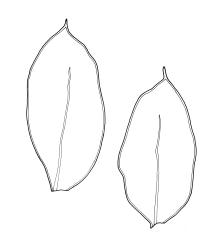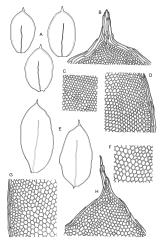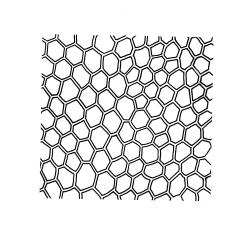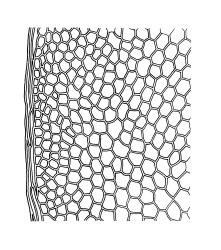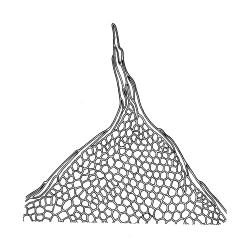- ≡ Hookeria adnata Hook.f. & Wilson in Wilson, Bot. Antarct. Voy. II (Fl. Nov.-Zel.) Part II, 123 (1854)
- ≡ Mniadelphus adnatus (Hook.f. & Wilson) Reichardt, Reise Novara 1, 186 (1870)
- ≡ Distichophyllum adnatum (Hook.f. & Wilson) Broth., Nat. Pflanzenfam. [Engler & Prantl] 1(3), 928 (1907)
- = Distichophyllum nadeaudii Besch., Ann. Sci. Nat., Bot. sér. 7, 20: 43 (1894)
- = Distichophyllum integerrimum Mül.Hal., Hedwigia 41: 122 (1902)
Plants iridescent when dry, forming loose to ± compact mats. Stems ± prostrate, moderately and irregularly branched, to at least 15 mm. Shoots c. 3 mm wide. Leaves weakly to moderately crisped when dry, not obscuring the complanate appearance of the shoot, 1.4–2.3 × 0.7–1.1 mm; upper laminal cells firm-walled, hexagonal, (12–)18–24(–30) × 12–18 µm, becoming larger (to 60 µm), laxer, and somewhat more oblong towards insertion; border narrow, c. 6–15 µm at mid leaf. Costa unbranched or weakly spurred, extending ½–¾ the leaf length.
Autoicous. Perichaetial leaves ovate-acuminate, not or weakly bordered, c. 900 µm long. Perigonia gemmiform, scattered on fertile stems, with ± cuspidate, ecostate, scarcely bordered bracts c. 400 µm long. Setae 7–11 mm, capsules c. 0.8–1.0 mm; annulus and operculum not seen. Exostome teeth c. 240 µm long; endostome segments uniseriate, c. 150 µm, neither keeled nor perforate. Peristome and calyptra as per species. Spores 12–16 µm.
Wilson 1854, pl. 43, fig. 4 (as Hookeria adnata).
NI: N Auckland (Puketi State Forest, Ōmahuta State Forest, Bay of Islands, Waipoua Forest, near Kawerua, Waitakere Ranges) including offshore islands (LB, GB).
Polynesian? Mainland Australia (Qld*), Norfolk I.*, Tahiti*.
In shaded, moist sites in warm temperate forest; frequently epiphyllic on Trichomanes elongatum (and then mostly without close associates), but also occurring on tree trunks (including Rhopalostylis), rotten logs, and shaded soil. When growing terrestrially this variety is sometimes associated with Mittenia plumula. The three Queensland and one Norfolk I. collection examined all grew terrestrially.
Sainsbury (1955) recorded this taxon only from Little Barrier I. but it is here recorded as more widespread in N Auckland L.D.; several collections have been seen from the Far North and from various localities in the Waitakere Ranges.
The conclusions of Dixon (1927, p. 282) and Sainsbury (1955) that D. adnatum is best treated as a variety of D. crispulum are accepted here; this contrasts to my earlier acceptance of it at species rank (Fife 1995).
Type material (BM!) of D. nadeaudii Besch. (1894), as well as non-type Tahitian material collected by Nadeaud (CHR 637818!), can be referred to D. crispulum var. adnatum.
The lectotype of Hookeria adnata bears no collection data beyond "J.D.H." and Wilson’s herbarium number, but the protologue allows little doubt that this collection was made in 1841 at the Bay of Islands. The specimen is mounted on several cards with Wilson’s handwritten draft description.
Both Hookeria concinna Colenso (1886) nom. illeg. and Hookeria cataractae Colenso (1887) are excluded from the synonymy of Distichophyllum crispulum var. adnatum for reasons briefly discussed under "excluded taxa" of Distichophyllum.



